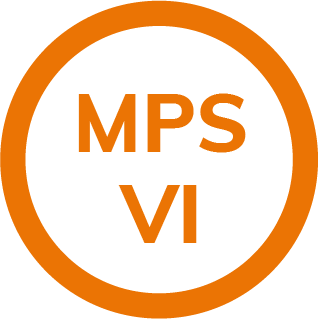
Rare Genetic Diseases
Mucopolysaccharidoses, commonly referred to as MPS, are a group of rare genetic metabolic disorders, and are regarded as lysosomal storage disorders.
Normally, the body makes enzymes to break down materials for our cells. For people with MPS and related diseases, the missing or insufficient enzyme prevents that normal process for the sugar glycosaminoglycans (or mucopolysaccharides), so they become stored in almost every cell of the body. As a result, cells do not function properly and cause progressive damage to the person throughout the body, including the heart, bones, joints, respiratory system, and nervous system. While the disease is not immediately apparent at birth, signs and symptoms develop with age as more cells become damaged by the accumulation of cell deposits. Most patients usually do not live through their twenties.
Mucopolysaccharidoses exist in a total of seven types — MPS I, II, III, IV, VI, VII, IX — and numerous subtypes. There are no type V and VIII. The seven types are subdivided to subtypes according to enzyme defect and symptoms shown by the body. Although each type of MPS is clinically different, most patients generally experience a period of normal development and then followed by a decline in physical and/or mental function.
Number of MPS patients in our organisation = 25; Number of patients with rare diseases in our organisation = 36; Total Number of MPS + Rare Diseases Patients = 61 (Updated: 11 April 2024)

Syndrome

Incidence Estimates
Cause
Symptoms and Treatments

Syndrome

Incidence Estimates
Cause
Symptoms and Treatments

Syndrome

2

Incidence Estimates
Cause
Symptoms and Treatments

Syndrome

Incidence Estimates
Cause
Symptoms and Treatments

Syndrome

3

Incidence Estimates
Cause
Symptoms and Treatments

Syndrome

9
Incidence Estimates
Cause

Syndrome

8
Incidence Estimates
Cause
Symptoms and Treatments

Syndrome

3
Incidence Estimates
Cause
Symptoms and Treatments


0
Incidence Estimates


0
Incidence Estimates
Cause

0
Incidence Estimates
Cause
Symptoms and Treatments

8
Cause
Symptoms and Treatments

1
Incidence Estimates
Cause
Symptoms and Treatments

5
Incidence Estimates
Cause
Symptoms and Treatments
Hemolytic Uremic Syndrome

2
Incidence Estimates
Symptoms and Treatments

1
Incidence Estimates
Cause
Symptoms and Treatments

1
Incidence Estimates
Cause
Symptoms and Treatments

0
Incidence Estimates
Cause
Symptoms and Treatments
epidermolysis bullosa

1
Incidence Estimates
Cause
Symptoms and Treatments

1
Incidence Estimates
Cause
Symptoms and Treatments

1
Incidence Estimates
Cause
Symptoms and Treatments
deletion of chromosome 3q23 to 3q25

1

1
Cause
Symptoms and Treatments

1
Incidence Estimates
Cause
Symptoms and Treatments

1
Incidence Estimates
Cause
Symptoms and Treatments
Huntington’s Disease, however, is not as simple as it seems. Chorea which typically causes an unsteady gait is only one of the first symptoms of the disease. Other accompanying symptoms include swallowing and speech difficulties. As the disease progresses, it also affects a number of mental and cognitive abilities, as well as certain aspects of personality.
Huntington’s Disease patients usually develop symptoms after mid-adult life. In the later stage of the disease, eating, speech and mobility are extremely difficult if not impossible, and they may eventually become bedridden, facing an increased risk of infection.
Each child of a person with Huntington’s Disease has a 50% chance of inheriting the gene. It is devastating not only to the patients but also to their families.
There is, at present, no cure for Huntington’s Disease, but treatments are available to slow down the symptoms and help the patients function for as long and as comfortably as possible. The care and support of family and friends is profoundly critical to Huntington’s Disease patients.

1
Incidence Estimates
Cause

2
Incidence Estimates
Cause

0
Incidence Estimates

1
Incidence Estimates
Symptoms and Treatments

0
Incidence Estimates
Symptoms and Treatments

1
hereditary
optic
neuropathy

1
Cause
Symptoms and Treatments
Hypoventilation Syndrome (CCHS)

1
Incidence Estimates
Cause
Symptoms and Treatments
Epiphyseal Dysplasia

1
Incidence Estimates
Cause
Symptoms and Treatments
Muscular Dystrophy

1
Incidence Estimates
Cause
Symptoms and Treatments

1








